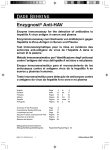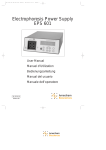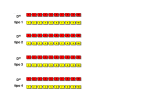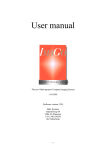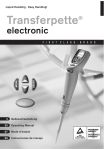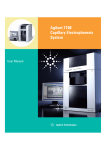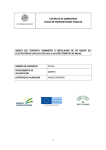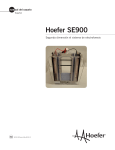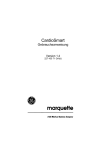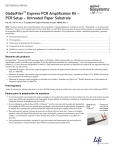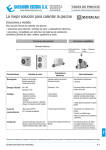Download hl-2-1300p_2007-12(7) [igg ief].qxp
Transcript
IgG-IEF Instructions For Use REF 102100 (Double Antibody) REF 102200 (Single Antibody) IEF-IgG kit Fiche technique REF 102100 ( Double anticorps) REF 102200 (Simple anticorps) IgG IEF Kit Anleitung REF 102100 (Double Antikörper) REF 102200 (Single Antikörper) IgG IEF KIT Istruzioni per l’uso REF 102100 (doppio anticorpo) REF 102200 (singolo anticorpo) Kit IgG-IEF Instrucciones de uso REF 102100 (anticuerpo doble) REF 102200 (anticuerpo simple) Contents English Français Deutsch Italiano Español 1 8 15 23 30 IGG-IEF INTENDED PURPOSE The IgG IEF Kit is intended for the identification of IgG-specific oligoclonal banding in serum and CSF by agarose gel isoelectric focusing and immunoblotting. The Helena BioSciences IgG-IEF Kit is based 1 upon the method originally described by Keir, G. et al . The diagnosis of multiple sclerosis is ultimately a clinical decision, although the analysis of cerebrospinal fluid gives evidence of an inflammatory response within the central nervous system, showing oligoclonal bands on the immunoglobulin electrophoresis pattern. In 1994, the Committee of the European Concerted Action for Multiple Sclerosis recommended isoelectric focusing as the most 2 sensitive method for the detection of oligoclonal bands in serum and CSF . The IgG IEF Kit separates serum or CSF proteins according to isoelectric point in an agarose IEF gel, pH 3-10. The proteins are then transferred to nitrocellulose, and the nitrocellulose immunofixed to visualise IgG specific bands. The patterns are interpreted qualitatively by comparing the presence or absence of oligoclonal bands in serum and/or CSF. WARNINGS AND PRECAUTIONS All reagents are for in-vitro diagnostic use only. Do not ingest or pipette by mouth any kit component. Refer to product safety data sheet for risk and safety phrases and disposal information. COMPOSITION 1. IgG IEF Gel (×10) Contains agarose and separators, pH 3-10 with thiomersal as preservative. The gel is ready for use as packaged. 2. IgG IEF Anode Solution (1 × 25ml) Contains 0.3M acetic acid. The solution is ready for use as packaged. 3. IgG IEF Cathode Solution (1 × 25ml) Contains 1M NaOH. The solution is ready for use as packaged. 4. IgG IEF Blocking Agent (1 × 10g) Contains bovine milk protein solids. IgG-IEF Blocking Agent is used to prepare 2 working solutions: Blocking Solution A: Dissolve 1g powder in 50ml of saline solution. Blocking Solution B: Dilute 5ml of blocking solution A to 50ml with saline solution. 5. IgG IEF Acetate Buffer Concentrate (1 × 25ml) Contains 0.2M acetate buffer pH 5.1. Dilute 2.5ml of Acetate Buffer concentrate to 25ml with purified water prior to use and use immediately. 6. IgG IEF Chromagen (1 × 0.05g) Contains 3-amino-9-ethyl-carbazole powder. Dissolve the contents of the vial in 50ml of pure methanol. Store 5ml aliquots at -20°C in the dark. Use glassware dedicated for this purpose to prevent protein contamination of the chromagen. 7. Antibodies for 102100 Kit: IgG IEF Primary Antibody (1 × 240µl) Contains sheep anti-human IgG antiserum and is ready for use as packaged. IgG IEF Secondary Antibody (1 × 200µl) Contains anti-sheep IgG peroxidase conjugate and is ready for use as packaged. 8. Antibodies for 102200 Kit: IgG IEF Single Antibody (1 × 200µl) Contains sheep anti-human IgG peroxidase conjugate and is ready for use as packaged. 1 English 9. Other Kit Components Each kit contains Instructions For Use and sufficient Blotting Membranes, Blotters C and D, Electrode Wicks, Wick Blotters and Soak-away Blotters to complete 10 gels. STORAGE AND SHELF-LIFE 1. IgG IEF Gel Gels should be stored at 15...30°C and are stable until the expiry date indicated on the package. DO NOT REFRIGERATE OR FREEZE. Deterioration of the gel may be indicated by 1) crystalline appearance indicating the gel has been frozen, 2) cracking and peeling indicating drying of the gel or 3) visible contamination of the agarose from bacterial or fungal sources. 2. IgG IEF Anode Solution The anode solution should be stored at 15...30°C and is stable until the expiry date indicated on the label. Cloudiness or particulate contamination may indicate deterioration. 3. IgG IEF Cathode Solution The cathode solution should be stored at 15...30°C and is stable until the expiry date indicated on the label. Cloudiness or particulate contamination may indicate deterioration. 4. IgG IEF Blocking Agent The blocking agent should be stored at 15...30°C and is stable until the expiry date indicated on the label. The IgG-IEF Blocking Agent should be a free-flowing white or off-white lumpy powder, any changes to this appearance, or unusual colouration may indicate deterioration. 5. IgG IEF Acetate Buffer Concentrate The buffer concentrate should be stored at 15...30°C and is stable until the expiry date indicated on the label. Cloudiness or particulate contamination may indicate deterioration. 6. IgG IEF Chromagen The chromagen should be stored at 2...6°C and is stable until the expiry date indicated on the label. Frozen aliquots are stable for 6 months. The Chromagen solution should be a red-brown colour, changes from this appearance or failure of the chromagen to perform in the test may indicate deterioration. 7. Antibodies for 102100 Kit: IgG IEF Primary Antibody The primary antibody solution should be stored at 2...6°C and is stable until the expiry date indicated on the label. Particulate contamination or cloudiness may indicate deterioration. IgG IEF Secondary Antibody The secondary antibody solution should be stored at 2...6°C and is stable until the expiry date indicated on the label. Particulate contamination or cloudiness may indicate deterioration. 8. Antibodies for 102200 Kit: IgG IEF Single Antibody The single antibody solution should be stored at 2...6°C and is stable until the expiry date indicated on the label. Particulate contamination or cloudiness may indicate deterioration. 2 IgG-IEF ITEMS REQUIRED BUT NOT PROVIDED Cat. No. 4065 Helena IEF Chamber Cat. No. 1525 EPS 600 Power Supply Cat. No. 1349/1111 REP IEF/SPIFE IEF Electrode Assembly Cat. No. 5014 Development Weight Cat. No. 3039 Chamber Cooling Device 30 volume hydrogen peroxide Methanol 10% methanol solution Drying oven with forced air capable of 60...70°C Saline Solution (0.85% NaCI) Purified water SAMPLE COLLECTION AND PREPARATION Freshly collected serum or CSF is the specimen of choice. Samples can be stored refrigerated at 2...6°C for up to 3 days or 2 weeks at -20°C. CSF samples should be applied neat. Serum samples should be diluted in physiological saline to an IgG concentration equivalent to the matched CSF sample. STEP-BY-STEP PROCEDURE 1. Remove the gel from the packaging and place on a paper towel. Remove the overlay and blot the gel surface with a blotter C, discard the blotter. 2. Soak 1 electrode wick in the anode solution and blot almost dry between two wick blotters. Position this wick along the anode (+) edge of the gel. Repeat this for the cathode solution and position along the cathode (-) edge of the gel. NOTE: Take care not to mix the anode and cathode solutions. 3. Apply 5µl of sample to each sample well. NOTE: Follow procedure according to instrument. 4a. Running in a REP unit: i. Use a REP IEF electrode assembly. Dispense 500µL of di-water onto the chamber. Place the gel into the chamber by positioning the anode wick under the central anode electrode of the REP IEF Electrode Assembly and the cathode wick under the outside cathode electrode. Position one soak-away blotter on the outside of the cathode electrode and one soak-away blotter on the outside of the anode electrode to act as excess fluid blotters. Ensure the soak-aways are in contact with the gel. ii. Program the following parameters into the REP (leaving all other sections of the program screen blank): Electrophoresis Voltage Electrophoresis Time Electrophoresis Temperature Standby Temperature iii. 600-800 volts 45:00 mm:ss 10...20°C 16°C Slide the chamber lid to close and press F1 to commence the run. 3 English 4b. Running in a SPIFE / SAS-3 unit: i. Use a SPIFE / SAS-3 IEF electrode assembly. Position gel as described in 4a (i). ii. Program the following parameters into the SPIFE / SAS-3: Electrophoresis End of test 45:00 mm:ss 10°C 800 volts iii. Close the chamber lid and press START to commence electrophoresis. 4c. Running in the SAS-1 Plus unit: i. Dispense 400µL of di-water onto the heat sink. Place the gel onto the heat sink, agarose side up, aligning the positive and negative sides with the corresponding electrode posts, taking care to avoid air bubbles under the gel. ii. Attach the electrodes onto the top side of the electrode posts so that they are in contact with the buffer wicks. iii. Perform the IgG-IEF electrophoresis: Number of applications Electrophoresis Voltage Electrophoresis Temperature Electrophoresis Time Incubation 0 600 volts 15°C 60:00 mm:ss OFF 4d. Running in conventional IEF systems: i. The following parameters should be used if using alternative IEF systems: Power Volts Limit Current Limit Run Time Run Temperature 10-20 watts 600-1200 volts 50mA 30:00 mm:ss 10...20°C 4e. Running in the Helena IEF Chamber: i. The following parameters should be used with the Helena IEF chamber: Electrophoresis Voltage Electrophoresis Time 400 volts 60 mm:ss NOTE: The voltage, time and temperature chosen for the focusing should be determined by each individual laboratory according to pattern length required. The temperature should also be chosen to minimise condensation on the gel surface which can lead to smearing of the patterns. Avoid overfocusing of the gel, as cathode drift of the gradient can result in the loss of proteins into the cathode wick, as well as the introduction of breaks in the gradient. When using Helena IEF chamber ensure the cooling device has been cooled to 5°C before use. 4 IgG-IEF 5. Following focusing, place the gel onto a blotter D. Remove the electrode wicks. 6. Pre-wet a sheet of transfer membrane in purified water. Remove excess water by gently blotting between two paper towels or tissues. Carefully place this sheet of transfer membrane, red dot down, onto the gel surface. Allow the membrane to take up moisture as it is placed on the gel surface to prevent the production of air pockets. Leave for 10 seconds and discard. 7. Pre-wet a second sheet of transfer membrane in purified water or 10% methanol solution. Allow excess fluid to drain from the membrane by holding the membrane vertical for 10-20 seconds. Carefully lay this transfer membrane, red dot down, onto the gel surface, and rub the surface of the membrane to ensure good gel contact and the removal of air pockets between the gel and the membrane (avoid excessive pressure which could damage the gel). Place a blotter C, three blotter D’s and a development weight on top. Press for 30 minutes. 8. Discard the blotters and place the transfer membrane, red dot up, into a staining dish containing 20 ml of blocking solution A so that the whole surface of the membrane is covered. Gently agitate for 30 minutes. 9. Wash the membrane in purified water several times. 10a.DOUBLE ANTIBODY PROCEDURE Place the membrane in 15ml of blocking solution B containing 15µl of primary antibody for 30 minutes with gentle agitation. Wash the membrane in purified water several times and, finally, in saline solution for 5 minutes. Place the membrane in 15ml of blocking solution B containing 15µl of secondary antibody for 30 minutes with gentle agitation. 10b.SINGLE ANTIBODY PROCEDURE Place the membrane in 15ml of blocking solution B containing 15µl of single step antibody for 30 minutes with gentle agitation. 11. Wash the membrane in purified water several times and, finally, in saline solution for 5 minutes. Rinse in purified water. Place the membrane in a solution of 25ml acetate buffer (diluted as specified), 5ml chromagen solution and 25µl of hydrogen peroxide. Allow colour to develop for 20 minutes with gentle agitation. It is normal for precipitation of chromagen to occur during this step. 12. Wash the membrane in purified water several times and allow to air dry. INTERPRETATION OF RESULTS 2 For a full review of the interpretation of IgG-IEF patterns, see Andersson, M. et al . The IgG bands become visible as a red/red brown colour on the membrane. Comparison of paired serum/CSF samples should always be the standard procedure. Various disease states show monoclonal or oligoclonal IgG bands. Multiple Sclerosis (MS) patients typically show oligoclonal IgG in the CSF without bands in the serum. The interpretation of the patterns obtained should be performed with the aid of the clinical history of the patient. QUALITY CONTROL The use of CSF from a donor positive for oligoclonal bands is recommended for use on each gel as a control sample to confirm all stages of the procedure in the absence of a commercially available control material. 5 English TROUBLESHOOTING The following table details possible reasons and solutions to some of the most commonly encountered problems associated with isoelectric focusing followed by immunoblotting. Problem Observed Possible Reasons and Solutions No staining of sample lanes. a) No samples applied. b) Primary and/or secondary antibody omitted. c) No hydrogen peroxide added. Background heavily and uniformly stained. a) Blocking step omitted. b) Inadequate washing of the transfer membrane during the immunofixation and colouration steps. Background heavily but unevenly stained. a) Omitted or inadequate pre-blot step Sample lanes stained but faint. a) b) c) d) e) f) Insufficient sample applied. Insufficient staining time. Old or contaminated hydrogen peroxide. Decay of antibodies due to incorrect storage. Oxidised chromagen (will appear black). pH of acetate buffer incorrect (should be 5.0 - 5.2). Sample lanes intensely stained. a) Excessive sample applied losing resolution. b) Overdeveloped (rare). Sample lanes distorted/smeared. a) No soak-aways used. b) Condensation on gel surface due to excessive cooling of the gel. All staining in the sample well. a) No power applied during electrophoresis. White spots in the stained sample. a) Air bubbles between gel and membrane at press stage. b) Ensure a pre-wet membrane is used and that bubbles are rubbed out from between the membrane and gel. PERFORMANCE CHARACTERISTICS Sensitivity A discrete band was evident on the membrane at a concentration of IgG equivalent to 0.28mg/L in the CSF. Reproducibility a. Within-gel A single CSF sample showed the same pattern of bands when tested in all 10 wells of a single gel. b. Between-gel The same sample was tested on 3 different gels and showed the same pattern of bands on each of the gels. 6 IEF-IgG Specificity The antibodies used in the kit were shown to be specific for IgG, and did not cross-react with human IgA or IgM. BIBLIOGRAPHY 1. Keir, G. et al. ‘Isoelectric focusing of cerebrospinal fluid immunoglobulin G: An annotated update’. Ann. Clin. Biochem., 1990;27:436-443. 2. Andersson, M. et al. ‘Cerebrospinal fluid in the diagnosis of multiple sclerosis: a consensus report.’ J Neurol. Neurosurg. Psychiatry, 1994; 57:897-902. 7 English UTILISATION Le kit IEF IgG est utilisé pour l'identification des bandes oligoclonales spécifiques aux IgG dans le sérum et le LCR par isoélectrofocalisation (IEF) en gel d'agarose et immunobloting. Le kit Helena BioSciences 1 IEF IgG est basé sur une technique décrite par Keir G. et al. . Le diagnostique de multiple scléroses est finalement une décision clinique, bien que l'analyse du liquide céphalorachidien mette en évidence une réponse inflammatoire du système nerveux central, montrant des bandes oligoclonales d'immunoglobulines sur la séparation électrophorétique. En 1994, le comité Européen d'action concertée pour les multiples scléroses recommande l'isoélectrofocalisation comme 2 la méthode la plus sensible pour la détection de bandes oligoclonales dans le sérum ou le LCR . Le kit IEF IgG sépare les protéines du sérum ou du LCR grâce à leur point isoélectrique en gel agarose IEF pH 3-10. Les protéines sont ensuite transférées sur nitrocellulose, la membrane de nitrocellulose est ensuite traitée par des anticorps afin de visualiser les bandes spécifiques d'IgG. L'interprétation qualitative est réalisée par comparaison de la présence ou absence de bandes oligoclonales dans le sérum et/ou le LCR. PRECAUTIONS Tous les réactifs sont à usage diagnostic in-vitro uniquement. Ne pas ingérer ou pipeter à la bouche aucun composant. Se reporter aux fiches de sécurité des composants du kit pour la manipulation et l'élimination. COMPOSITION 1. IEF IgG plaque de gel. (×10) Contient de l'agarose et des séparateurs, pH 3-10 avec du thimérosal comme conservateur. Le gel est prêt à l'emploi. 2. IEF IgG Solution anodique. (1 × 25ml) Contient de l'acide acétique à 0.3M. La solution est prête à l'emploi. 3. IEF IgG Solution cathodique. (1 × 25ml) Contient une solution de NaOH à 1M. La solution est prête à l'emploi. 4. IEF IgG Agent de blocage. (1 × 10g) Contient des protéines de lait bovines en poudre. L'agent de blocage est utilisé pour la préparation de 2 solutions de travail: Solution de blocage A: Dissoudre 1g de poudre dans 50ml de solution saline. Solution de blocage B: Diluer 5 ml de solution de blocage A dans 50ml de solution saline. 5. IEF IgG Tampon acétate concentré. (1 × 25ml) Contient un tampon acétate 0.2M à pH 5.1. Diluer 2.5ml de tampon concentré dans 25ml d'eau distillée immédiatement avant utilisation. 6. IEF IgG Chromogène. (1 × 0.05g) Contient du 3-amino-9-éthyl-carbazole en poudre. Dissoudre le contenu du flacon dans 50ml de méthanol pur. Aliquoter par 5ml et conserver à -20°C dans le noir. Utiliser de la verrerie dédiée uniquement au chromogène afin d'éviter une contamination en protéine du chromgène. 7. Anticorps pour le kit Réf. 102100: IEF IgG Anticorps primaire. (1 × 240µl) Contient un antisérum de chèvre anti-IgG humaine et est prête à l'emploi. IEF IgG Anticorps secondaire. (1 × 200µl) Contient un antisérum anti-IgG de chèvre conjugué à une peroxydase et est prête à l'emploi. 8 IEF-IgG 8. Anticorps pour le kit Réf. 102200: IEF IgG Anticorps simple. (1 × 200µl) Contient un antisérum de chèvre anti-IgG humaine conjugué à une peroxydase et est prête à l'emploi. 9. Autres composants du kit. Chaque kit contient 1 fiche technique, également des membranes de transfert, des buvards C et D, des buvards électrodes, des buvards absorbants pour 10 gels. STOCKAGE ET CONSERVATION 1. IEF IgG Plaque de gel. Les gels doivent être conservés entre 15...30°C, ils sont stables jusqu'à la date d'expiration indiquée sur l'emballage. NE PAS REFRIGERER OU CONGELER. Les conditions suivantes indiquent une détérioration du gel: 1) cristaux visibles indiquant que le gel a été congelé, 2) de craquelures témoins d'une déshydratation du gel, 3) une contamination visible bactérienne ou fongique. 2. IEF IgG Solution Anodique. La solution anodique doit être conservée entre 15...30°C, elle est stable jusqu'à la date de péremption indiquée sur l’etiquette. Une contamination ou une aspect floconneux indique une détérioration. 3. IEF IgG Solution Cathodique. La solution cathodique doit être conservée entre 15...30°C, elle est stable jusqu'à la date de péremption indiquée sur l’etiquette. Une contamination ou une aspect floconneux indique une détérioration. 4. IEF IgG Agent de blocage. La agent de blocage doit être conservée entre 15...30°C, elle est stable jusqu'à la date de péremption indiquée sur l’etiquette. L'agent de blocage doit être une poudre granuleuse de couleur crème, tout changement de son aspect ou une coloration inhabituelle indique une détérioration. 5. IEF IgG Tampon acétate concentré. La tampon concentré doit être conservée entre 15...30°C, elle est stable jusqu'à la date de péremption indiquée sur l’etiquette. Un aspect nuageux ou une contamination indique une détérioration. 6. IEF IgG Chromogène. La chromogène doit être conservée entre 2...6°C, elle est stable jusqu'à la date de péremption indiquée sur l’etiquette. Les aliquots congelés sont stables 6 mois. Le chromogène en solution doit avoir une coloration rouge-brune, un changement d'apparence ou une perte de volume du chromogène (aliquot) indique une détérioration. 7. Anticorps pour Kit 102100. IEF IgG Anticorps primaire La solution d'anticorps primaire doit être conservée entre 2...6°C, elle est stable jusqu'à la date de péremption indiquée sur l’etiquette. Un aspect nuageux ou une contamination indique une détérioration. IEF IgG Anticorps secondaire La solution d'anticorps secondaire doit être conservée entre 2...6°C, elle est stable jusqu'à la date de péremption indiquée sur l’etiquette. Un aspect nuageux ou une contamination indique une détérioration. 9 Français 8. Anticorps pour kit 102200. IEF IgG Anticorps simple La solution d'anticorps simple doit être conservée entre 2...6°C, elle est stable jusqu'à la date de péremption indiquée sur l’etiquette. Un aspect nuageux ou une contamination indique une détérioration. MATERIELS NECESSAIRES NON FOURNIS Réf. 4065 Helena Chambre de migration pour IEF Réf. 1525 Générateur EPS 600 Réf. 1349 / 1111 Electrodes REP pour IEF / Electrodes SPIFE pour IEF. Réf. 5014 Poids à développement Réf. 3039 Élément réfrigérant (Cooling Device) Etuve ventilée jusqu’à 70°C Méthanol 10% de Méthanol 30 Vol. d'eau oxygénée Solution saline (0.85% NaCl) Eau distillée PRELEVEMENTS DES ECHANTILLONS L'utilisation de sérums ou LCR fraîchement prélevés est fortement recommandée. Les échantillons peuvent être conservés 3 jours entre 2...6°C ou 2 semaines à -20°C. Le LCR doit être déposé pur. Le sérum doit être dilué en eau physiologique pour ramener la concentration des IgG sériques à celle du LCR. METHODOLOGIE 1. Sortir le gel de son emballage et le déposer sur un papier absorbant. Retirer le film et sécher toute la surface du gel à l'aide d'un buvard C, jeter ensuite le buvard. 2. Humidifier un buvard électrode avec la solution anodique et le sécher entre deux buvards fins. Déposer le buvard électrode sur le bord du gel côté anodique (+). Répéter cette étape avec la solution cathodique et déposer le buvard électrode sur le bord du gel côté cathodique (-). NOTE: Prendre soin de ne pas mélanger les solutions cathodique et anodique. 3. Déposer 5µL d'échantillon dans chaque puits. NOTE: Suivre la procédure selon votre type d’instrument. 4a. Utilisation d’un instrument REP: i. Utiliser le bloc d’électrodes IEF du REP. Pipeter 500µl de solution d’eau désionisée dans la chambre. Introduire le gel dans la chambre en plaçant le pont papier anodique sous l’anode centrale du bloc d’électrodes IEF du REP et le pont papier cathodique sous la cathode latérale. Placer un buvard anti-écoulement à l’extérieur de la cathode et un autre à l’extérieur de l’anode pour absorber le fluide en excès. Vérifier qu’ils sont en contact avec le gel. 10 IEF-IgG ii. Régler les paramètres suivants sur le REP (en laissant toutes les autres sections du programme vides): Tension de l’électrophorèse Durée d'électrophorèse Température de l’électrophorèse Température d'attente 600-800 Volts 45:00 mm:ss 10...20°C 16°C iii. Coulisser le couvercle de la chambre pour la fermer et appuyer sur F1 pour démarrer le programme. 4b. Utilisation d’un instrument SPIFE / SAS-3: i. Utiliser le bloc d’électrodes IEF du SPIFE / SAS-3. Placer le gel comme indiqué au paragraphe 4a (i). ii. Régler les paramètres suivants sur le SPIFE / SAS-3: Électrophorèse Fin du programme 45:00 mm:ss 10°C 800 volts iii. Fermer le couvercle de la chambre, appuyer sur START et suivre les messages pour démarrer l’électrophorèse. 4c. Utilisation d’un instrument SAS-1 Plus: i. Pipeter 400µl de d’eau désionisée dans le dissipateur thermique. Placer le gel sur le dissipateur thermique, agarose vers le haut, en respectant les polarités et en veillant à ce qu’il n’y ait pas de bulles d’air sous le gel. ii. Fixer les électrodes sur le haut des plots que sorte qu’elles soient en contact avec les ponts de papier. iii. Réaliser l’électrophorèse Hb-IEF: Nombre d'applications Tension de migration Température de migration Durée d'électrophorèse Incubation 0 600 Volts 15°C 60:00 mm:ss Non 4d. Utilisation de systèmes d’isoélectrofocalisation conventionnels: i. Utiliser les paramètres suivants avec les systèmes d’IEF alternatifs: Puissance Tension limite Intensité limite Durée du processus Température du processus 10-20 watts 600-1200 volts 50mA 30:00 mm:ss 10...20°C 11 Français 4e. Utilisation d’une chambre IEF Helena: i. Utiliser les paramètres suivants avec les chambres d’IEF Helena: Tension de l’électrophorèse Durée de l’électrophorèse 400 volts 60 minutes NOTE: La tension, la durée et la température de migration pour la focalisation doivent être ajustées par chaque laboratoire en fonction de la longueur de migration désirée. La température doit être choisie afin de minimiser la condensation à la surface du gel qui peut produire une effet de flou sur les migrations. Une trop forte focalisation du gel, peut être du à une augmentation du gradient au niveau de la cathode se qui entraîne une perte de protéines dans le buvard cathodique, comme à une rupture du gradient de pH. En cas d'utilisation de la chambre IEF Helena, s'assurer que le refroidisseur (cooling device) est à 5°C avant utilisation. 5. A la fin de focalisation, déposer le gel sur une buvard D. Retirer les buvards électrodes. 6. Humidifier une première membrane de transfert dans l'eau distillée. Retirer l'excès d'humidité en plaçant la membrane entre deux papier absorbant. Placer cette membrane délicatement sur le gel, point rouge vers le bas. Procéder très doucement pour permettre à la membrane de s'humidifier au contact du gel, en évitant la formation de bulles d'air. Laisser en contact 10 secondes et retirer la membrane. 7. Humidifier une seconde membrane de transfert dans l'eau distillée ou dans une solution à 10% de méthanol. Retirer l'excès d'humidité en égouttant la membrane verticalement pendant 10 à 20 secondes. Délicatement déposer la membrane sur le gel, point rouge vers le bas. Lisser la membrane afin d'assurer un contact étroit entre celle-ci et le gel et d'éliminer les bulles d'air (ne pas appuyer trop fort afin de ne pas endommager le gel). Placer sur la membrane un buvard C, trois buvards D et un poids à développement, presser pendant 30 minutes. 8. Enlever le poids, les buvards et déposer la membrane de transfert, point rouge vers le haut, dans un récipient propre contenant 20ml de solution de blocage A. La surface entière de la membrane doit être recouverte. Laisser en contact sous agitation douce pendant 30 minutes. 9. Laver la membrane plusieurs fois dans l'eau distillée. 10a.TECHNIQUE DOUBLE ANTICORPS Placer la membrane dans 15ml de solution de blocage B additionnée de 15µL d'anticorps primaire. Laisser en contact 30 minutes sous agitation douce. Laver la membrane plusieurs fois dans l'eau distillée et en final 5 minutes dans l'eau physiologique. Déposer la membrane dans 15ml de solution de blocage B additionnée de 15µL d'anticorps secondaire. Laisser en contact 30 minutes sous agitation douce. 10b.TECHNIQUE SIMPLE ANTICORPS Placer la membrane dans 15ml de solution de blocage B additionnée de 15µL d'anticorps simple. Laisser en contact 30 minutes sous agitation douce. 11. Laver la membrane plusieurs fois dans l'eau distillée et en final 5 minutes dans l'eau physiologique. Rincer dans l'eau distillée. Placer la membrane dans une solution de 25ml de tampon acétate (préparé comme indiqué), 5ml de chromogène et 25µL d'eau oxygénée. Laisser la coloration se développée pendant 20 minutes sous agitation douce. Il est normal de voir apparaître un précipité à ce stade. 12. Rincer dans plusieurs bains d'eau distillée et laisser sécher la membrane. 12 IgG IEF INTERPRETATION DES RESULTATS Pour une interprétation complète des profils IEF des IgG, se référer à la bibliographie Andersson, M. 2 et al . Les bandes d'IgG apparaissent colorées en rouge/brun sur la membrane. La comparaison des bandes doit toujours être faite par couple LCR / Sérum. Plusieurs pathologies montrent des bandes d'IgG monoclonales ou polyclonales. La sclérose multiple (MS) fait apparaître des bandes oligoclonales surnuméraires dans le LCR par rapport au sérum. L'interprétation des profils doit être confronté au dossier clinique du patient. CONTROLE DE QUALITE L'utilisation de LCR d'un donneur positif avec des bandes oligoclonales est recommandé sur chaque gel afin de permettre de vérifier toutes les étapes de la procédures en l'absence d'un contrôle commercialisé. GUIDE D'UTILISATION La table suivante détaille les principaux problèmes et solutions pouvant être communément rencontrés lors de l'utilisation de cette technique d'isofocalisation et d'immunoblottage. Problèmes rencontrés Raisons et solutions Pas de coloration des bandes. a) Pas d'échantillons appliqués. b) Anticorps primaire/secondaire omis. c) Oubli de l'eau oxygénée. Fond de bande important et uniforme. a) Solution de blocage omise. b) Mauvais lavage de la membrane après immunofixation ou coloration. Fond de bande important et non uniforme. a) Omission ou mauvais pré-blottage. Echantillon coloré mais faiblement. a) b) c) d) Coloration des bandes trop intense. a) Application excessive d'échantillon. b) Temps de développement excessif (rare). Migrations tordues/floues. a) Absence de buvards absorbeurs d'humidité. b) Condensation excessive à la surface du gel, refroidissement trop important. Insuffisance d'échantillon. Temps de coloration insuffisant. Eau oxygénée trop vieille ou contaminée. Dégradation des anticorps due à une mauvaise conservation. e) Oxydation du chromogène (coloration noir). f) pH du tampon acétate incorrecte (doit être entre 5.0-5.2). Coloration uniquement des puits de dépôt. a) Pas de migration électrophorétique. Points blancs dans la coloration des échantillons. a) Bulles d'air emprisonnées entre le gel et la membrane de transfert. Utiliser une membrane humidifier pour chasser les bulles. 13 Français PERFORMANCES Sensibilité Une discrète bande est mise en évidence sur la membrane à une concentration de 0.28mg/l d’IgG dans le LCR. Reproductibilité a. Intra-gel Un échantillon de LCR présente des bandes identiques en nombre et aspect, lorsque celui-ci est testé dans les 10 puits d’un même gel. b. Inter-gel La même échantillon testé sur 3 gels différents, présente les mêmes bandes sur chaque gel. Spécificité Les anticorps utilisés dans le kit sont dirigés uniquement contre les IgG et ne présentent pas de réations croissées avec les IgA ou IgM. BIBLIOGRAPHIE. 1. Keir, G. et al. ‘Isoelectric focusing of cerebrospinal fluid immunoglobulin G: An annotated update’. Ann. Clin. Biochem., 1990;27:436-443. 2. Andersson, M. et al. ‘Cerebrospinal fluid in the diagnosis of multiple sclerosis: a consensus report.’ J Neurol. Neurosurg. Psychiatry, 1994; 57:897-902. 14 IgG IEF ANWENDUNGSBEREICH Der Helena IgG IEF Kit ist bestimmt zum Nachweis von IgG-spezifischen oligoklonalen Banden im Serum und Liquor mittels isoelektrischer Fokussierung im Agarosegel und anschlieflendem 1 Immunblotting. Der Kit beruht auf der Methode, die zuerst von G. Keir et al. beschrieben wurde. Die Diagnose von Multiple Sklerose ist letztendlich eine klinische Entscheidung, obwohl im Falle einer Entzündung des Zentralnervensystems die Analyse der Zerebrospinalflüssigkeit oligoklonale Banden auf dem Immunoglobulin-Elektophorese-Bandenmuster ergibt. Im Jahr 1994 wurde die isoelektrische Fokussierung vom Europäischen Ausschuss für Multiple Sklerose als die schonendste Methode des Nachweises von oligoklonalen Banden im Serum oder Liquor empfohlen. Mit dem IgG IEF Kit werden Serum- oder Liquorproteine zuerst entsprechend ihres isoelektrischen Punktes im Agarose IEF Gel (pH 3-10) aufgetrennt und anschlieflend auf eine Nitrozellulosefolie übertragen. Die Nitrozellulosefolie wird immunfixiert, um die IgG-spezifischen Banden sichtbar zu machen. Die Interpretation der Banden erfolgt qualitativ durch Vergleich der An- oder Abwesenheit von oligoklonalen Banden im Serum und/oder Liquor. WARNHINWEISE UND VORSICHTSMASSNAHMEN Alle Reagenzien sind nur zur In-Vitro-Diagnostik bestimmt. Nicht einnehmen oder mit dem Mund pipettieren. Bitte lesen Sie das Sicherheitsdatenblatt zu diesem Produkt hinsichtlich der Gefahrenhinweise und Sicherheitsratschläge, sowie die Informationen zur Entsorgung durch. INHALT 1. IgG IEF Gel (×10) Enthält Agarose und Separatoren (pH 3-10) mit Thiomersal als Konservierungsmittel. Das Gel ist gebrauchsfertig verpackt. 2. IgG IEF Anoden-Lösung (1 × 25ml) Enthält 0,3M Essigsäure. Die Lösung ist gebrauchsfertig verpackt. 3. IgG IEF Kathoden-Lösung (1 × 25ml) Enthält 1M NaOH. Die Lösung ist gebrauchsfertig verpackt. 4. IgG IEF Blockier-Reagenz (1 × 10g) Enthält festes Rindermilchprotein. Wird für die Herstellung zweier Arbeitslösungen verwendet. Blockierlösung A: 1g Feststoff in 50ml physiologischer Kochsalzlösung lösen. Blockierlösung B: 5ml Blockierlösung A mit physiologischer Kochsalzlösung auf 50ml verdünnen. 5. IgG IEF Acetatpuffer (1 × 25ml) Enthält 0,2M Acetatpuffer (pH 5,1). 2,5ml Acetatpufferkonzentrat mit dest. Wasser auf 25ml vor Gebrauch verdünnen. Sofort verwenden. 6. IgG IEF Chromagen (1 × 0.05g) Enthält 3-Amino-9-Ethyl-Carbazol. Den Inhalt des Fläschchens in 50ml absol. Methanol lösen. In Aliquots zu je 5ml bei -20°C unter Lichtausschluss aufbewahren. Verwenden Sie nur spezielle Glaswaren für diesen Zweck, um Kontamination des Chromagens mit Proteinen zu vermeiden. 7. Antikörper für den 102100 Kit: IgG IEF Primär-Antikörper (1 × 240µl) Enthält Schaf-Anti-Human-IgG-Antiserum und ist gebrauchsfertig verpackt. IgG IEF Sekundär-Antikörper (1 × 200µl) Enthält Anti-Schaf-IgG-Peroxidase-Konjugat und ist gebrauchsfertig verpackt. 15 Deutsch 8. Antikörper für den 102200 Kit: IgG IEF Single Antikörper (1 × 200µl) Enthält Schaf-Anti-Human-IgG-Peroxidase-Konjugat und ist gebrauchsfertig verpackt. 9. Weitere Kit-Komponenten Jede Packung enthält eine Anleitung, ausreichend Blotterfolien, Blotter C und D, Elektrodenpapier, Papierblotter und “Soak-away”-Streifen für 10 Gele. LAGERUNG UND STABILITÄT 1. IgG IEF Agarosegel Gele sollten bei 15...30°C gelagert werden und sind bis zum aufgedruckten Verfallsdatum stabil. NICHT IM KÜHLSCHRANK ODER TIEFKÜHLSCHRANK AUFBEWAHREN! Der Verfall des Gels zeigt sich durch 1) Kristallisation, die auf ein Einfrieren des Gels hindeutet, 2) Brüchigkeit und Abblättern, die auf ein Austrocknen des Gels hindeuten, bzw. 3) sichtbare Kontaminierung der Agarose durch Bakterien oder Pilze. 2. IgG IEF Anoden-Lösung Die Lösung sollte bei 15...30°C gelagert werden und ist bis zum aufgedruckten Verfallsdatum stabil. Trübung oder teilweise Verunreinigung können auf einen Verfall des Produkts hinweisen. 3. IgG IEF Kathoden-Lösung Die Lösung sollte bei 15...30°C gelagert werden und ist bis zum aufgedruckten Verfallsdatum stabil. Trübung oder teilweise Verunreinigung können auf einen Verfall des Produkts hinweisen. 4. IgG IEF Blockier-Reagenz Das Pulver sollte bei 15...30°C gelagert werden und ist bis zum aufgedruckten Verfallsdatum stabil. Das IgG IEF Blockier-Reagenz sollte ein rieselfähiges weifles oder off-weifles klumpiges Pulver sein. Ändert sich das Aussehen oder tritt eine ungewöhnliche Färbung auf, so könnte dies auf einen Verfall des Produkts hinweisen. 5. IgG IEF Acetatpuffer Die Lösung sollte bei 15...30°C gelagert werden und ist bis zum aufgedruckten Verfallsdatum stabil. Trübung oder teilweise Verunreinigung können auf einen Verfall des Produkts hinweisen. 6. IgG IEF Chromagen Das Chromogen sollte bei 2...6°C gelagert werden und ist bis zum aufgedruckten Verfallsdatum stabil. Gefrorene Aliquots sind 6 Monate stabil. Die Chromagenlösung sollte eine rot-braune Farbe haben. Aussehensänderung oder Leistungsschwäche des Chromagens im Test kann auf einen Verfall des Produkts hinweisen. 7. Antikörper für den 102100 Kit: IgG IEF Primär-Antikörper Die Primär-Antikörper-Lösungen sollten bei 2...6°C gelagert werden und sind bis zum aufgedruckten Verfallsdatum stabil. Teilweise Verunreinigung oder Trübung können auf einen Verfall hinweisen. IgG IEF Sekundär-Antikörper. Die Sekundär-Antikörper-Lösungen sollten bei 2...6°C gelagert werden und sind bis zum aufgedruckten Verfallsdatum stabil. Teilweise Verunreinigung oder Trübung können auf einen Verfall hinweisen. 8. Antikörper für den 102200 Kit: IgG IEF Single Antikörper Die Single Antikörper-Lösungen sollten bei 2...6°C gelagert werden und sind bis zum aufgedruckten Verfallsdatum stabil. Teilweise Verunreinigung oder Trübung können auf einen Verfall hinweisen. 16 IgG IEF NICHT MITGELIEFERTES, ABER BENÖTIGTES MATERIAL Kat. Nr. 4065 Helena IEF-Kammer Kat. Nr. 1525 EPS 600 Netzteil Kat. Nr. 1349/1111 REP IEF/SPIFE IEF Elektrodensatz Kat. Nr. 5014 Entwicklungsgewicht Kat. Nr. 3039 Kühlplatte für Kammer Methanol 10%iger Methanol/Wasser-Lösung 30%iges Wasserstoffperoxid Trockenschrank mit Umluft und einer Temperaturleistung von 60...70°C. Kochsalzlösung (0,85% NaCl) Dest. Wasser PROBENAHME UND VORBEREITUNG Frisches Serum oder Liquor ist das Material der Wahl. Die Proben können bis zu 3 Tage bei 2...6°C oder 2 Wochen bei -20°C gelagert werden. Liquorproben sollten unverdünnt aufgetragen werden. Serumproben vor dem Auftragen mit physiologischer Kochsalzlösung auf die IgG-Konzentration des eingesetzten Liquors verdünnen. SCHRITT-FÜR-SCHRITT METHODE 1. Nehmen Sie das Gel aus der Verpackung und legen Sie es auf ein Papiertuch. Entfernen Sie vorsichtig die Schutzfolie, blotten Sie kurz die Geloberfläche mit einem Blotter C und entfernen Sie diesen. 2. Befeuchten Sie ein schmales Elektrodenpapier mit der Anodenlösung und blotten Sie es zwischen zwei Papierblottern nahezu trocken. Positionieren Sie es entlang der Anodenseite (+) auf die Geloberfläche. A nalog verfahren Sie mit der Kathodenlösung. Positionieren Sie das mit der Kathodenlösung befeuchtete Papier entlang der Kathodenseite (-) auf die Geloberfläche. BITTE BEACHTEN: Achten Sie darauf, die Anoden- und Kathodenlösung nicht zu mischen. 3. Pipettieren Sie 5µl der jeweiligen Probe in jede Auftragestelle. Hinweis: Bitte beachten Sie die Durchführungshinweise für das entsprechende Gerät. 4a. Lauf mit einem REP-Gerät: i. Einen REP-IEF-Elektrodensatz verwenden. 500µl entionisiertem Wasser auf die Kammer pipettieren. Das Gel in die Kammer legen, indem der Anodenstreifen unter die zentrale Anodenelektrode des REP-IEF-Elektrodensatz positioniert wird und den Kathodenstreifen unter die Kathodenelektrode an der Außenseite. Einen „Soak-Away“-Blotter an die Außenseite der Kathodenelektrode positionieren und einen an die Außenseite der Anodenelektrode zum Aufsaugen überschüssiger Flüssigkeit. Sicherstellen, dass die „Soak-Away“-Blotter Kontakt mit dem Gel haben. 17 Deutsch ii. Folgende Parameter in den REP programmieren (alle anderen Abschnitte des Programmbildschirm leer lassen): Elektrophorese-Spannung Elektrophorese-Dauer Elektrophorese-Temperatur Standby-Temperatur 600-800 Volt 45:00 mm:ss 10...20°C 16°C iii. Den Kammerdeckel zuschieben und F1 drücken, um den Lauf zu starten. 4b. Lauf mit einem SPIFE / SAS-3-Gerät: i. Einen SPIFE / SAS-3-IEF-Elektrodensatz verwenden. Das Gel wie in 4a (i) beschrieben positionieren. ii. Das SPIFE/SAS-3 Gerät mit den folgenden Parametern programmieren: Elektrophorese Testende 45:00 mm:ss 10°C 800 Volt iii. Den Kammerdeckel schließen und START drücken. Den Eingabeaufforderungen zum Start der Elektrophorese folgen. 4c. Lauf mit einem SAS-1 Plus-Gerät: i. 400µL entionisiertem Wasser auf das Kühlblech pipettieren. Das Gel mit der Agaroseseite nach oben auf die Kühlplatte legen, die positive und negative Seite an den passenden Elektrodenhaltern ausrichten. Darauf achten, dass unter dem Gel keine Luftblasen sind. ii. Befestigen Sie die Elektroden oben auf den Elektrodenhaltern, damit sie mit den Pufferstreifen in Kontakt sind. iii. Hb-IEF Elektrophorese durchführen: Zahl von Applikationen Spannung Elektrophorese Temperatur Elektrophorese Zeit Elektrophorese Inkubation 0 600 Volt 15°C 60:00 mm:ss Nein 4d. Lauf mit konventionellen IEF-Systemen: i. Die folgenden Parameter sollten bei Verwendung eines anderen IEF-Systems eingestellt werden: Strom Volt Grenzwert Spannung Grenzwert Laufdauer Lauftemperatur 10-20 Watt 600-1200 Volt 50mA 30:00 mm:ss 10...20°C 18 IgG IEF 4e. Lauf mit der Helena IEF-Kammer: i. Die folgenden Parameter sollten bei Verwendung der Helena IEF-Kammer eingestellt werden: Elektrophoresespannung Elektrophorese-Dauer ii. 400 Volt 60 Minuten Sicherstellen, dass das Kühlelement der Kammer für mindestens 30 Minuten vor Gebrauch bei 2...6°C gelagert wurde. In den mittlere Vertiefung der Kammer legen. BITTE BEACHTEN: Spannung, Zeit und Temperatur für die Fokussierung sollten von jedem Labor hinsichtlich der benötigten Laufweite der Spuren individuell ermittelt werden. Die Temperatur sollte so eingestellt werden, dass ein Minimum an Kondensation auf der Geloberfläche erreicht wird, da zu starke Kondensation zu Verschmieren der Spuren führen kann. Zu starke Fokussierung des Gels muss ebenfalls vermieden werden, weil Kathodendrift des pH-Gradienten zu Verlust von Proteinbanden im Kathodenpapier führen kann, sowie zu Unterbrechungen im Gradienten. Bei Gebrauch der Helena IFEKammer muss darauf geachtet werden, dass der Kühlblock vor Gebrauch ausreichend bei 5°C gekühlt wurde. 5. Nach der Fokussierung legen Sie das Gel es auf einen Blotter D. Entfernen Sie die Elektrodenpapiere. 6. Feuchten Sie eine Transfermembran mit dest. Wasser an. Überschüssiges Wasser wird durch leichtes Blotten zwischen zwei Papiertüchern entfernt. Legen Sie die Folie (roter Punkt nach unten!) leicht auf die Geloberfläche. Die Membran soll Feuchtigkeit aufsaugen, wenn sie auf das Gel gelegt wird, damit sich keine Luftblasen bilden. Nach 10 Sekunden abziehen und verwerfen. 7. Feuchten Sie eine zweite Transfermembran mit dest./entionisiertem Wasser oder mit 10%iger Methanol/Wasser-Lösung an. Überschüssige Flüssigkeit wird durch vertikales Halten der Folie für ca. 10-20 Sekunden entfernt. Legen Sie die Transfermembran (roter Punkt nach unten!) vorsichtig auf die Geloberfläche. Streichen Sie mit dem Finger über die Oberfläche der Membran, um guten Kontakt zwischen Gel und Membran sowie den Ausschluss von Luftblasen zu gewährleisten (vermeiden Sie exzessives Pressen, um das Gel nicht zu zerstören). Legen Sie auf die Transfermembran einen Blotter C, drei Blotter D und das Entwicklungsgewicht und pressen Sie 30 Minuten. 8. Entfernen Sie die Blotter und legen Sie die Membran (roter Punkt nach oben!) in 20ml Blockierlösung A. Achten Sie darauf, dass die gesamte Oberfläche der Membran von Flüssigkeit bedeckt ist. Lassen Sie die Blockierlösung unter leichter Bewegung für 30 Minuten einwirken. 9. Waschen Sie die Membran mehrmals mit Wasser. 10a.DOUBLE-ANTIKÖRPER-METHODE Legen Sie die Membran in eine Lösung aus 15ml Blockierlösung B und 15µl Primär-Antikörper. 30 Minuten unter leichter Bewegung einwirken lassen. Waschen Sie die Membran mehrmals mit Wasser und anschlieflend 5 Minuten in physiologischer Kochsalzlösung. Legen Sie die Membran in eine Lösung aus 15ml Blockierlösung B und 15µl Sekundär-Antikörper. 30 Minuten unter leichter Bewegung einwirken lassen. 19 Deutsch 10b.SINGLE-ANTIKÖRPER-METHODE Legen Sie die Membran in eine Lösung aus 15ml Blockierlösung B und 15µl Single-Step-Antikörper. 30 Minuten unter leichter Bewegung einwirken lassen. 11. Waschen Sie die Membran mehrmals mit Wasser und anschlieflend 5 Minuten in physiologischer Kochsalzlösung. Zum Schluss mit dest. Wasser abspülen. Legen Sie die Membran in eine Lösung aus 25ml Acetatpuffer (nach Vorschrift verdünnt), 5ml Chromagen-Lösung und 25µl Wasserstoffperoxid. 20 Minuten unter leichter Bewegung einwirken lassen. Es ist normal, dass bei diesem Reaktionsschritt Chromagen ausfällt. 12. Spülen Sie die Membran mehrmals mit Wasser ab und lassen Sie sie an der Luft trocknen. AUSWERTUNG DER ERGEBNISSE Eine vollständige Zusammenfassung zur Interpretation von IgG-IEF-Bandenmustern ist bei M. 2 Andersson et al. zu finden. Die IgG-Banden werden als rot-braune Banden auf der Membran sichtbar. Die Interpretation beruht dabei auf dem Vergleich der Serum- und Liquorproben eines Patienten. Verschiedene Krankheitsbilder zeigen dabei monoklonale oder oligoklonale IgG-Banden. Patienten mit Multipler Sklerose (MS) zeigen typischerweise oligoklonale IgG-Banden im Liquor, nicht aber im Serum. Die Interpretation der Spuren sollte vor dem Hintergrund der Krankheitsgeschichte des Patienten erfolgen. QUALITÄTSKONTROLLE Bei Nichtverfügbarkeit des handelsüblichen Kontrollmaterials wird die Verwendung von Liquorspenderproben, die oligoklonalen Banden ergeben haben, empfohlen. 20 IgG IEF FEHLERSUCHE In der folgenden Tabelle sind einige beobachtete Probleme, die bei der isoelektrischen Fokussierung mit anschlieflendem Immunblotting auftreten können, sowie mögliche Ursachen beschrieben. Beobachtetes Problem Mögliche Ursachen und Lösungen Fokussierte Spuren nicht gefärbt. a) Keine Proben appliziert. b) Kein Antikörper zugegeben. c) Kein Wasserstoffperoxid zugegeben. Hintergrund stark und gleichmäflig gefärbt. a) Blottingschritt ausgelassen. b) Membran nicht genügend gespült während der Immunfixation und Färbung. Hintergrund stark, aber ungleichmäflig gefärbt. a) Ausgelassener oder nicht gut durchgeführter Pre-Blottingschritt. Fokussierte Spuren zu schwach gefärbt. a) b) c) d) Fokussierte Spuren zu stark unter Verlust der Auflösung gefärbt. a) Zu viel Probe appliziert bzw. zu hohe Konzentration der Probe. b) Überentwickelt (selten). Fokussierte Spuren verzerrt oder verschmiert. a) Keine “Soak-aways” benutzt. b) Zu grofle Kondensation aufgrund zu starker Kühlung während der Fokussierung. Gesamte Färbung nur in den Auftragestellen. a) Während der Elektrophorese keine Spannung angelegt. Weifle Punkte in den gefärbten Spuren. a) Luftblasen zwischen Gel und Membran während des Blottingschritts mit dem Entwicklungsgewicht. Sicherstellen, dass eine angefeuchtete Membran verwendet wird und Luftblasen durch leichtes Streichen mit dem Fingerüber die Membran entfernt werden. Nicht genügend Probe appliziert. Färbezeit zu kurz. Altes oder kontaminiertes H2O2 verwendet. Verlust der Antikörper-Aktivität aufgrund falscher Lagerung. e) Oxidiertes Chromagen (erscheint in schwarzer Farbe). f) pH des Acetatpuffers nicht korrekt (pH 5,05,2). 21 Deutsch LEISTUNGSDATEN Sensitivität Eine diskrete Bande war bis zu einer Konzentration von 0.28mg/l im Liquor auf der Membran nachweisbar. Reproduzierbarkeit a. Intraassay Eine Probe wurde auf allen 10 Spuren getestet und zeigte ein identisches Bandenmuster. b. Interassay Die gleiche Probe wurde auf drei Gelen (n=30) analysiert und das Resultat war jedesmal identisch. Spezifität Antikörper, die in diesem Kit verwendet werden, sind spezifisch gegen IgG und zeigen keine Kreuzreaktion gegen humanes IgA oder IgM. LITERATUR 1. Keir, G. et al., “Isoelectric focusing of cerebrospinal fluid immunoglobulin G: An annotated update”. Ann. Clin. Biochem., 1990; 27:436-443. 2. Andersson, M. et al., “Cerebrospinal fluid in the diagnosis of multiple sclerosis: a consensus report.” J. Neurol. Neurosurg. Psychiatry, 1994; 57:897-902. 22 IgG IEF PRINCIPIO Il kit IgG IEF é stato formulato per l’ identificazione delle bande oligoclonali specifiche IgG nel siero e nel liquor, mediante isoelettrofocusing su gel di agarosio e successivo immunoblotting. Il Kit IgG IEF é 1 basato su metodologie originali descritte da Keir,G. e al. nel 1990 . La diagnosi della sclerosi multipla é fondamentalmente una decisione clinica, sebbene l’analisi del liquido cerebrospinale mette in evidenza una risposta infiammatoria a livello del sistema nervoso centrale, mostrando bande oligoclonali nei tracciati elettroforetici. Nel 1994, il Comitato Europeo per la diagnosi della Sclerosi Multipla, ha raccomandato l’isoelettrofocalizzazione come il metodo più sensibile 2 per rilevare le bande oligoclonali nel siero e nel liquor . Il kit IgG permette di separare le proteine seriche e liquorali a seconda del loro punto isoelettrico, mediante isoelettrofocusing su gel di agarosio con gradiente di pH = 3 - 10. Le proteine vengono poi trasferite su una membrana nitrocellulosa, quindi immunofissate con anticorpi specifici per evidenziare le bande specifiche IgG. Il tracciato viene poi interpretato qualitativamente comparando la presenza / assenza delle bande oligoclonali nel siero e nel liquor (CSF o liquido cefalorachidiano). AVVERTENZE E PRECAUZIONI Tutti i reagenti sono solo per uso diagnostico in vitro. Non ingerire o pipettare con la bocca alcun componente del kit. Fare riferimento alle schede dati di sicurezza del prodotto per conoscere i rischi dei componenti, la sicurezza nell’utilizzarli ed altre informazioni. COMPOSIZIONE 1. Piastre IgG IEF (×10) Contengono agarosio e separatori a gradiente di pH = 3-10, con timerosal come conservante. Il gel è pronto per l’uso. 2. Soluzione Anodica (1 × 25ml) Contiene acido acetico 0.3M. La soluzione é pronta per l’uso. 3. Soluzione Catodica (1 × 25ml) Contiene NaOH 1 M. La soluzione é pronta per l’uso. 4. Agente bloccante (1 × 10g) Contiene proteine di latte bovino in polvere.Viene utilizzato per preparare 2 soluzioni di lavoro: - Soluzione bloccante A: Sciogliere 1g di polvere in 50ml di fisiologica. - Soluzione bloccante B: Diluire 5ml di soluzione A a 50ml con fisiologica. 5. Tampone acetato concentrato (1 × 25ml) Contiene tampone acetato 0.2M, pH 5.1.Prima dell’uso diluire 2.5ml di tampone acetato concentrato a 25ml con acqua distillata ed usare immediatamente. 6. Cromogeno (1 × 0.05g) Contiene 3-amino-9-etil-carbazolo in polvere. Sciogliere il contenuto del flaconcino in 50ml di metanolo puro. Dividere in aliquote da 5ml e conservare a -20°C, al riparo dalla luce. Utilizzare materiale di vetro apposito per questo passaggio, per prevenire la contaminazione del cromogeno con le proteine. 23 Italiano 7. Anticorpi per Cod. 102100 - IgG IEF Anticorpo primario (1 × 240µl) Contiene antisiero anti IgG umane, proveniente da capra e é pronta per l’uso. - IgG IEF anticorpo secondario (1 × 200µl) Contiene antisiero anti IgG di capra coniugato con perossidasi e é pronta per l’uso. 8. Anticorpi per Cod. 102200 (singolo anticorpo) (1 × 200µl) Contiene antisiero, proveniente da capra, anti IgG umane coniugato con perossidasi e é pronta per l’uso. 9. Altri componenti del kit Ogni kit contiene le istruzioni per l’uso, membrane di nitrocellulosa per immunoblotting, blotter C e D, bibule per ponti elettroforetici, vaschette per i lavaggi e la colorazione in quantità sufficiente per l’utilizzo delle 10 piastre di gel. CONSERVAZIONE E STABILITA’ 1. IgG IEF I gels devono essere conservati a 15...30°C e sono stabili fino alla data di scadenza riportata sulla confezione. Non refrigerare e/o congelare. Il deterioramento del gel può essere indicato da: 1) la presenza di cristalli sulla superficie,dovuta al congelamento, 2) rottura ed assottigliamento del gel, dovuti all’asciugatura, 3) contaminazione visibile da parte di batteri o funghi sporigeni. 2. Soluzione anodica La soluzione anodica deve essere conservata a 15...30°C ed é stabile fino alla data di scadenza riportata sull’etichetta. Torbidità oppure particolare contaminazione possono indicare il deterioramento del prodotto. 3. Soluzione catodica La soluzione catodica deve essere conservata a 15...30°C ed é stabile fino alla data di scadenza riportata sull’etichetta. Torbidità oppure particolare contaminazione possono indicare la contaminazione del prodotto. 4. Agente bloccante La polvere deve essere conservata a 15...30°C ed é stabile fino alla data di scadenza riportata sull’etichetta. L’ agente bloccante si presenta come una polvere bianca. Un aspetto diverso può indicare un deterioramento del prodotto. 5. Tampone acetato concentrato La soluzione deve essere conservata a 15...30°C ed é stabile fino alla data di scadenza indicata sull’etichetta. Torbidità oppure particolare contaminazione può indicare il deterioramento del prodotto. 6. Cromogeno La chromogeno deve essere conservata a 2...6°C ed é stabile fino alla data di scadenza riportata sull’etichetta. Le aliquote congelate sono stabili per 6 mesi. La soluzione deve essere di colore rosso-marrone. Un aspetto diverso oppure una performance errata del cromogeno, può indicare il deterioramento del prodotto. 24 IgG-IEF 7. Anticorpi per il cod. 102100 -Anticorpo pimario L’ anticorpo pimario deve essere conservato a 2...6°C ed é stabile fino alla data di scadenza riportata sull’etichetta. Particolare contaminazione oppure torbidità possono indicare il deterioramento del prodotto. -Anticorpo secondario L’ anticorpo secondario deve essere conservato a 2...6°C ed é stabile fino alla data di scadenza riportata sull’etichetta. Particolare contaminazione oppure torbidità possono indicare il deterioramento del prodotto. 8. Anticorpi per il cod.102200 (singolo anticorpo) L’anticorpo singolo deve essere conservato a 2...6°C ed é stabile fino alla data di scadenza riportata sull’etichetta. Particolare contaminazione oppure torbidità possono indicare il deterioramento del prodotto. MATERIALE RICHIESTO MA NON FORNITO Cod. 4065 Camera IEF Helena Cod. 1525 Alimentatore EPS 600 Cod. 1349/1111 Gruppo elettrodi REP IEF/SPIFE IEF Cod. 5014 Peso di sviluppo Cod. 3039 Dispositivo di raffreddamento camera Metanolo Metanolo al 10% 30 volumi acqua ossigenata Forno di essiccazione ad aria forzata con temperature di 60...70°C Soluzione fisiologica (0,85% NaCI) Acqua distillata RACCOLTA E PREPARAZIONE DEL CAMPIONE Si consiglia di utilizzare campioni di siero e CSF freschi. I campioni possono essere conservati a 2...6°C fino a 3 giorni o 2 settimane a -20°C. I campioni di liquor devono essere trattati indiluiti, mentre i campioni di siero devono essere diluiti con soluzione fisiologica per ottenere una concentrazione di IgG equivalente alle IgG del campione di liquor. PROCEDURA 1. Rimuovere il gel dalla confezione e collocarlo su un blotter. Rimuovere il film protettivo ed asciugare la superficie del gel con un blotter C. Scatare il blotter. 2 Imbibire una bibula (wick) con la soluzione anodica, asciugarla tra 2 blotter più spessi, quindi posizionarla lungo il lato anodico(+), all’estremità del gel. Ripetere l’operazione con un’altra bibula imbibita nella soluzione catodica e adagiarla lungo la parte catodica (-) all’estremità del gel. NOTA: Fare attenzione a non mescolare le soluzioni catodica e anodica. 3. Applicare 5µl di campione, in ogni pozzetto. 25 Italiano NOTA: Seguire la procedura secondo il tipo di strumento. 4a. Esecuzione in un’unità REP: i. Utilizzare un gruppo elettrodi REP IEF. Pipettare 500µl di acqua deionizzata nella camera. Introdurre il gel nella camera posizionando lo stoppino anodico sotto l’elettrodo anodico centrale del gruppo elettrodi REP IEF e lo stoppino catodico sotto l’elettrodo catodico esterno. Posizionare un blotter di assorbimento sull’esterno dell’elettrodo catodico e un blotter di assorbimento sull’esterno dell’elettrodo anodico, in modo tale che fungano da blotter per il liquido in eccesso. Assicurarsi che i blotter di assorbimento siano a contatto con il gel. ii. Impostare i seguenti parametri nel REP (lasciando vuote tutte le altre sezioni della videata del programma): Tensione di elettroforesi Tempo di elettroforesi Temperatura di elettroforesi Temperatura di stand-by 600-800 Volt 45:00 mm:ss 10...20°C 16°C iii. Fare scorrere il coperchio della camera per chiuderlo e premere F1 per iniziare il ciclo. 4b. Esecuzione in un’unità SPIFE / SAS-3: i. Utilizzare un gruppo elettrodi SPIFE / SAS-3 IEF. Posizionare il gel come descritto al punto 4a (i). ii. Impostare i seguenti parametri nella SPIFE / SAS-3: Elettroforesi Fine del test 45:00 mm:ss 10°C 800 Volt iii. Chiudere il coperchio della camera, premere START e seguire le indicazioni per iniziare l’elettroforesi. 4c. Esecuzione in un’unità SAS-1 Plus: i. Pipettare 400µL di acqua deionizzata sul dissipatore di calore. Collocare il gel sul dissipatore di calore con l’agarosio rivolto verso l’alto, allineando i lati positivo e negativo rispetto ai corrispondenti puntali degli elettrodi, prestando attenzione ad evitare bolle d’aria sotto il gel. ii. Fissare gli elettrodi sul lato superiore dei puntali, in modo tale che entrino a contatto con gli stoppini tampone. iii. Eseguire l’elettroforesi Hb-IEF: Numero di applicazioni Voltaggio Temperatura elettroforesi Tempo elettroforesi Incubazione 0 600 Volts 15°C 60:00 mm:ss OFF 26 IgG-IEF 4d. Esecuzione in sistemi IEF tradizionali: i. Qualora si utilizzino sistemi IEF alternativi, dovranno essere adottati i seguenti parametri: Potenza Limite di tensione Limite di corrente Durata ciclo Temperatura ciclo 10-20 Watt 600-1200 Volt 50mA 30:00 mm:ss 10...20°C 4e. Esecuzione nella camera IEF Helena: i. Con la camera IEF Helena devono essere utilizzati i seguenti parametri: Tensione di elettroforesi Tempo di elettroforesi ii. 400 Volt 60 minuti Assicurarsi che il dispositivo di raffreddamento della camera sia stato conservato a 2...6°C per almeno 30 minuti prima dell’uso. Introdurlo nel pozzetto centrale della camera. NOTA: Il voltaggio,tempo e temperatura scelte per il focusing devono essere determinate da ogni singolo laboratorio, in base alla lunghezza del tracciato che si vuole ottenere. La temperatura può essere scelta per minimizzare la condensa sulla superficie del gel, la quale potrebbere infuire sui tracciati provocandone la distorsione. Utilizzando il sistema “Chamber IEF Helena” si deve utilizzare il mezzo di raffreddamento, conservato prima dell’uso a 5°C. 5. Dopo la migrazione, collocarlo il gel su un blotter D. Rimuovere le bibule (wicks) dal gel. 6. Inumidipe in acqua distillata una membrana di trasferimento. Rimuovere l’eccesso dell’acqua asciugandola delicatamente tra 2 blotter. Collocarla delicatamente sulla superfice del gel con il bollino rosso rivolto verso il basso. Premere delicatamente la membrana su tutta la superficie per circa 10 secondi eliminando eventualmente tutte le bolle d’aria. Eliminare quindi la membrana. 7. Inumidire una seconda membrana di trasferimento con acqua distillata oppure metanolo al 10%. Eliminare l’eccesso di liquido, mettendo la membrana per 10-20 secondi in posizione verticale. Successivamente collocare la membrana sulla superficie del gel, sempre con il bollino rosso rivolto verso il basso, adagiandola lentamente facendo molta attenzione ad eventuali bolle d’aria. Porre 1 blotter C + 3 blotter D + un peso di sviluppo. Attendere per 30 minuti. 8. Eliminare i blotter ed il gel. Collocare la membrana di nitrocellulosa con il bollino rosso verso l’alto, nella vaschetta contenente 20ml di soluzione bloccante A. Agitare lentamente per30 minuti. 9. Sciaquare,con diversi lavaggi, la membrana in acqua distillata. 10a.PROCEDURA ANTICORPO DOPPIO Collocare la membrana in 15ml di Soluzione bloccante B contenente 15ul dell’anticorpo primario. Lasciare 30 minuti su agitatore lento. Sciaquare,con diversi lavaggi la membrana in acqua distillata. Al termine collocarla in fisiologica per 5 minuti. Porre la membrana in 15ml di Soluzione bloccante B contenente 15ul dell’anticorpo secondario. Lasciare 30 minuti su agitatore lento. 10b.PROCEDURA ANTICORPO SINGOLO Porre la membrana in 15ml di soluzione bloccante B, contenente 15µl del singolo anticorpo. Lasciare 30 minuti su agitatore lento. 27 Italiano 11. Sciaquare, con diversi lavaggi la membrana in acqua distillata. Al termine collocarla in fisiologica per 5 minuti. Sciaquare in acqua distillata. Collocare la membrana in una soluzione costituita da 25ml di Tampone acetato (diluito come sopra specificato), 5ml di Cromogeno (preparato come sopra specificato) e 25µl di acqua ossigenata. Lasciare sviluppare il colore per 20 minuti su agitatore lento. E’ normale la precipitazione del cromogeno durante questa fase. 12. Sciacquare in acqua distillata diverse volte e lasciare asciugare la membrana di nitrocellulosa all’aria. INTERPRETAZIONE DEI RISULTATI 2 Per un completo esame interpretativo dei tracciati IgG IEF, vedere Andersson, M.et al . Il bandeggio in IgG viene rilevato sulla membrana, con un colore bruno rossiccio. Il risultato del liquor deve essere sempre associato a quello del siero. Molte patologie presentano bande IgG mono/oligoclonali. La Sclerosi Multipla (MS) presenta tipicamente IgG oligoclonali nel tracciato CSF ma non nel tracciato serico. La diagnosi deve comunque essere completata con altri test e con l’anamnesi del paziente. CONTROLLO DI QUALITA’ L’utilizzo di un liquor proveniente da un donatore positivo per bande oligoclonali, é raccomandato come controllo da usare su ogni gel per confermare tutti i passi della procedura. Questo in quanto in commercio non é disponibile un controllo. RISOLUZIONE GUASTI La seguente tabella elenca le possibili reazioni e soluzioni di alcuni dei più comuni problemi associati con l’isoelettrofocalizzazione seguita da immunoblotting. PROBLEMI OSSERVATI POSSIBILI REAZIONI E SOLUZIONI Campioni non colorati. a) campioni non applicati. b) non dispensati gli anticorpi primario e/o secondario. c) non utilizzata l’acqua ossigenata. Fondo scuro e colorazione uniforme. a) non eseguito lo step con la soluzione bloccante. b) Errati i lavaggi della membrana durante l’immunofissazione e colorazione. Fondo scuro ma colorazione non regolare. a) non eseguito o inadeguato il passaggio di blotting. Scarsa colorazione campioni. a) b) c) d) insufficiente quantità di campione seminato. insufficiente tempo di colorazione. acqua ossigenata vecchia o contaminata. decadimento anticorpi, dovuti ad una scorretta conservazione. e) cromogeno ossidato (appare di colore nero). f) pH del tampone acetato non corretto (dovrebbe essere 5,0 - 5,2). 28 IgG-IEF PROBLEMI OSSERVATI POSSIBILI REAZIONI E SOLUZIONI Campione colorato intensamente. a) eccessivo campione applicato con scarsa risoluzione. b) troppo colorato (raro). Campioni distorti/macchiati. a) non utilizzata la carta per assorbire l’eccesso di tampone, durante l’elettroforesi. b) condensa sulla superficie del gel dovuta ad un eccessivo raffreddamento del medesimo. Pozzetto completamente colorato. a) non é stata applicata corrente durante l’elettroforesi. Bolle bianche nei campioni colorati. a) presenza di bolle tra la membrana ed il gel durante la fase di pressata. CARATTERISTICHE DELLE PRESTAZIONI Sensibilità Nel CFS ad una concentrazione di IgG equivalento a 0.28mg/L é evidente una banda ben distinta. Riproducibilità a. entro il gel Un singolo campione di CFS testato in tutti e 10 i pozzetti di un gel, ha mostrato lo stesso pattern di bande. b. tra gel Lo stesso campione é stato testato su 3 differnti gels mostrando lo stesso pattern di bande su ciascun gel. Specificità Gli anticorpi utilizzati nel kit mostrano una specificità per le IgG, e non mostrano reazioni crociate con le IgA e IgM umane. BIBLIOGRAFIA 1. Keir, G. et al. ‘Isoelectric focusing of cerebrospinal fluid immunoglobulin G: An annotated update’. Ann. Clin. Biochem., 1990;27:436-443. 2. Andersson, M. et al. ‘Cerebrospinal fluid in the diagnosis of multiple sclerosis: a consensus report.’ J Neurol. Neurosurg. Psychiatry, 1994; 57:897-902. 29 Italiano USO PREVISTO El kit IgG IEF de está previsto para identificar la formación de bandas oligoclonales específicas de IgG en suero y CSF por isoelectroenfoque en gel de agarosa e inmunobloting. El kit IgG IEF de Helena 1 Biosciences se basa en el método descrito originalmente por G. Keir y otros . El diagnóstico de la esclerosis múltiple es, a la larga, una decisión clínica, aunque el análisis del liquido cefalorraquideo evidencia una respuesta inflamatoria dentro del sistema nervioso central, mostrando bandas oligoclonales en el patrón electroforético de la inmunoglobulina. En 1994, el Comité de Acción Concertada Europea para la Esclerosis Múltiple recomendó la concentración isoeléctrica como el 2 método más sensible para la detección de bandas oligoclonales en suero y CSF . El kit IgG IEF de separa proteínas de suero o CSF según el punto isoeléctrico en un gel IEF de agarosa, pH 3-10. Las proteínas son transferidas luego a nitrocelulosa, y la nitrocelulosa es inmunofijada para visualizar las bandas específicas de IgG. Los patrones son interpretados cualitativamente comparando la presencia o ausencia de bandas oligoclonales en suero y/o CSF. ADVERTENCIAS Y PRECAUCIONES Todos los reactivos son para utilizar únicamente en diagnóstico in vitro. No ingerir ni aspirar por la boca ningún componente del kit. Consultar en el prospecto de seguridad del producto las indicaciones sobre riesgos y seguridad así como la información acerca de su eliminación. COMPOSICION 1. Gel IgG IEF. (×10) Contiene agarosa y separadores, pH 3-10, con thiomersal como conservante. El gel viene envasado listo para usar. 2. Solución anódica IgG IEF. (1 × 25ml) Contiene ácido acético 0,3 M. La solución viene envasada lista para usar. 3. Solución catódica IgG IEF. (1 × 25ml) Contiene NaOH 1 M. La solución viene envasada lista para usar. 4. Agente bloqueante IgG IEF. (1 × 10g) Contiene proteínas de leche bovina en polvo. El agente bloqueante IgG-IEF se emplea para preparar 2 soluciones de uso: solución bloqueante A: disolver 1 gr. de polvo en 50ml de solución salina fisiológica; solución bloqueante B: diluir 5ml de la solución bloqueante A en 50ml de solución salina fisiológica. 5. Concentrado de acetato tampón IgG IEF. (1 × 25ml) Contiene tampón acetato 0,2 M, pH 5,1. Diluir 2,5ml del tampón de acetato concentrado en 25ml de agua destilada antes de su uso y utilizarlo inmediatamente. 6. Cromógeno IgG IEF. (1 × 0.05g) Contiene 3-amino-9-etilo-carbazole en polvo. Disolver el contenido del vial en 50ml de metanol puro. Guardar partes alícuotas de 5ml a -20°C en un lugar oscuro. Utilizar recipientes de cristal adecuados para este propósito, con el fin de evitar la contaminación proteínica del cromágeno. 7. Anticuerpos para el kit 102100: Anticuerpo primario IgG IEF (1 × 240µl) Contiene antisuero IgG antihumano de oveja y viene envasada lista para usar. Anticuerpo secundario IgG IEF (1 × 200µl) Contiene un conjugado de peroxidasa e IgG antiovino y viene envasada lista para usar. 30 IgG-IEF 8. Anticuerpos para el kit 102200: Anticuerpo simple IgG IEF (1 × 200µl) Contiene un conjugado de peroxidasa e IgG antihumano de oveja y viene envasada lista para usar. 9. Otros componentes del kit. Cada kit contiene Instrucciones de uso y suficientes papeles secantes - secantes C y D, mechas para electrodos, secantes de mechas y secantes absorbentes, hasta completar 10 geles. ALMACENAMIENTO Y PERIODO DE VALIDEZ 1. Gel IgG IEF. Los geles deben guardarse a una temperatura entre 15...30°C y son estables hasta la fecha de caducidad indicada en el envase. NO REFRIGERAR NI CONGELAR. El deterioro del gel puede ser indicado por: 1) aspecto cristalino, indicio de que el gel se ha congelado, 2) agrietamiento y exfoliación, indicio de que el gel se ha secado, o 3) contaminación visible de la agarosa por fuentes bacterianas o micóticas. 2. Solución anódica IgG IEF. La solución anódica debe guardarse a una temperatura entre 15...30°C y es estable hasta la fecha de caducidad indicada en la etiqueta. Turbiedad o contaminación por partículas pueden ser indicios de deterioro del producto. 3. Solución catódica IgG IEF. La solución catódica debe guardarse a una temperatura entre 15...30°C y es estable hasta la fecha de caducidad indicada en la etiqueta. Turbiedad o contaminación por partículas pueden ser indicios de deterioro del producto. 4. Agente bloqueante IgG IEF. Los polvos deben guardarse a una temperatura entre 15...30°C y es estables hasta la fecha de caducidad indicada en la etiqueta. El agente bloqueante IgG-IEF debe ser un polvo blanco de libre fluidez o grumoso de un color blanco mate. Cualquier cambio de este aspecto, o una coloración inusual, puede ser indicio de deterioro del producto. 5. Tampón concentrado de acetato IgG IEF. La solución debe guardarse a una temperatura entre 15...30°C y es estable hasta la fecha de caducidad indicada en la etiqueta. Turbidez o contaminación por partículas pueden ser indicios de deterioro del producto. 6. Cromógeno IgG IEF. El cromógeno deben guardarse a una temperatura entre 15...30°C y es estable hasta la fecha de caducidad indicada en la etiqueta. Partes alícuotas son estables durante 6 meses guardadas a -20°C. La solución de cromógeno debe ser de un color rojo-marrón. Cualquier cambio de este aspecto o un fallo del cromógeno durante la realización del ensayo puede ser indicio de deterioro del producto. 7. Anticuerpos para el kit 102100. Anticuerpo primario IgG IEF. Las soluciones de anticuerpos primario deben guardarse a temperaturas entre 15...30°C y son estables hasta la fecha de caducidad indicada en la etiquetal. Turbidez o contaminación por partículas pueden ser indicios de deterioro del producto. Anticuerpo secundario IgG IEF. Las soluciones de anticuerpos secundario deben guardarse a temperaturas entre 2...6°C y son estables hasta la fecha de caducidad indicada en la etiqueta. Turbidez o contaminación por partículas pueden ser indicios de deterioro del producto. 31 Español 8. Anticuerpos para el kit 102200. Anticuerpo simple IgG IEF. Las soluciones de anticuerpos simple deben guardarse a temperaturas entre 2...6°C y son estables hasta la fecha de caducidad indicada en la etiqueta. Turbidez o contaminación por partículas pueden ser indicios de deterioro del producto. ACCESORIOS NECESARIOS, NO SUMINISTRADOS Agua oxigenada, Nº de catálogo 4065 Cámara Helena IEF Nº de catálogo 1525 Fuente de alimentación EPS600 Nº de catálogo 1349/1111 Conjunto de electrodos de REP IEF/SPIFE IEF Nº de catálogo 5014 Peso de desarrollo N° de catálogo 3039 Dispositivo de enfriamiento de la cámara 30% de volumen de agua oxigenada Metanol 10% de metanol en agua Solución Salina (NaCl al 0,85%) Agua destilada. RECOGIDA Y PREPARACION DE MUESTRAS La muestra consistirá en suero o CSF recién obtenidos. Las muestras se pueden guardar refrigeradas a una temperatura entre 2...6°C hasta 3 días o 2 semanas a -20°C. Las muestras de CSF deben aplicarse puras, sin mezcla. Las muestras de suero se diluirán en una solución salina fisiológica hasta obtener una concentración de IgG equivalente a la muestra de CSF correspondiente. PROCEDIMIENTO PASO A PASO 1. Sacar el gel del envase y colocarlo sobre una servilleta de papel. Retirar la hoja protectora y secar la superficie del gel con un secante C, luego desechar el secante. 2. Empapar una mecha de electrodo en la solución anódica y dejarla secar casi por completo entre dos secantes de mechas. Colocar esta mecha a lo largo del lado anódico (+) del gel. Repetir esta operación para la solución catódica y colocar la mecha a lo largo del lado catódico (-) del gel. NOTA: Procurar no mezclar las soluciones anódica y catódica. 3. Aplicar 5µl de la muestra a cada pocillo. 32 IgG-IEF NOTA: Siga el procedimiento segun el tipo de instrumento. 4a. Desarrollo en una unidad REP: i. Use un conjunto de electrodos REP IEF. Pipetee 500µl de agua desionizada en la cámara. Coloque el gel en la cámara situando la mecha del ánodo bajo el electrodo del ánodo central del Conjunto de electrodos REP IEF y la mecha catódica bajo el electrodo catódico externo. Coloque un secante de empapar en la parte externa del electrodo catódico y un secante de empapar en la parte externa del electrodo anódico para actuar como secantes de exceso de líquido. Asegúrese de que los secantes para quitar el exceso de líquido están en contacto con el gel. ii. Programe los siguientes parámetros en el REP (dejando las otras secciones de la pantalla del programa en blanco): Voltaje de la electroforesis Tiempo de la electroforesis Temperatura de la electroforesis Temperatura de espera 600-800 voltios 45:00 mm:ss 10...20°C 16°C iii. Deslice la tapa de la cámara para cerrar y pulse F1 para comenzar el desarrollo. 4b. Desarrollo en una unidad SPIFE / SAS-3 unit: i. Use un conjunto de electrodos de IEF SPIFE / SAS-3. Coloque el gel como se describe en 4a (i). ii. Programe los siguientes parámetros en el SPIFE/SAS-3: Electroforesis Fin de la prueba 45:00 mm:ss 10°C 800 voltios iii. Cierre la tapa de la cámara, pulse START y siga las instrucciones para comenzar la electroforesis. 4c. Ejecución en una unidad SAS-1 Plus: i. Pipetee 400µL de agua desionizada en el disipador térmico. Coloque el gel en el disipador térmico, con el lado de agarosa hacia arriba, alineando los lados positivo y negativo con los bornes, teniendo cuidado de evitar las burbujas aéreas debajo del gel ii. Conectar los electrodos a la parte superior de los bornes, de forma que estén en contacto con los bloques tampón. iii. Realizar la electroforesis Hb-IEF: Número de aplicaciones: Voltaje: Temperatura de electroforesis: Tiempo de electroforesis: Incubación 0 600 V 15°C 60:00 mm:ss No 33 Español 4d. Desarrollo de sistemas de IEF convencionales: i. Se usarán los siguientes parámetros si se usan sistemas de IEF alternativos: Potencia Límite de voltios Límite actual Tiempo de desarrollo Temperatura de desarrollo 10-20 vatios 600-1200 voltios 50 mA 30:00 mm:ss 10...20°C 4e. Desarrollo en la cámara Helena IEF: i. Deben usarse los siguientes parámetros con la cámara Helena IEF: Voltaje de la electroforesis Tiempo de electroforesis ii. 400 voltios 60 minutos Asegúrese de que el dispositivo de enfriamiento de la cámara ha estado almacenado a 2...6°C durante al menos 30 minutos antes de su uso. Colocar en la hendidura central de la cámara. NOTA: El voltaje, el tiempo y la temperatura elegidos para el enfoque deberán ser determinados por cada laboratorio en particular, según la longitud de patrón requerida. La temperatura se elegirá también para reducir al mínimo la condensación de la superficie del gel, que puede llevar a la degradación de los patrones. Evitar un exceso de enfoque sobre el gel, ya que la deriva del gradiente del cátodo podría causar la pérdida de proteínas en la mecha del cátodo, así como la aparición de interrupciones en el gradiente. En el caso de utilizar una cámara Helena IEF, hay que asegurarse de que el dispositivo de refrigeración se ha enfriado hasta los 5°C antes de su uso. 5. A continuación del paso de enfoque, ponerlo el gel sobre un secante D. Retirar las mechas de los electrodos. 6. Humedecer primero una lámina de transferencia en agua destilada. Eliminar el exceso de agua presionandola suavemente entre dos toallitas o pañuelos de papel. Colocar con cuidado esta lámina de transferencia sobre la superficie del gel, con el punto rojo hacia abajo. Dejar que la lámina absorba la humedad mientras está colocada sobre el gel, para evitar la formación de burbujas de aire. Esperar durante 10 segundos y luego desecharla. 7. Humedecer primero una segunda lámina de transferencia en agua destilada / desionizada o en un 10% de metanol en agua. Dejar que se escurra el exceso de fluido de la lámina sujetándola en posición vertical durante unos 10 o 20 segundos. Colocar cuidadosamente esta lámina de transferencia sobre la superficie del gel, con el punto rojo hacia abajo, y frotar la superficie de la lámina para asegurar un buen contacto con el gel y la eliminación de burbujas de aire entre el gel y la lámina (evitar ejercer una presión excesiva que podría dañar el gel). Colocar un secante C, tres secantes D y un peso de laboratorio encima y luego presionar durante 30 minutos. 8. Desechar los secantes y colocar la lámina de transferencia, con el punto rojo hacia arriba, en una cavidad de coloración conteniendo 20ml de solución bloqueante A, de forma que toda la superficie de la lámina quede cubierta. Agitar suavemente durante 30 minutos. 9. Lavar la lámina en agua varias veces. 34 IgG-IEF 10. (a) PROCEDIMIENTO CON ANTICUERPO DOBLE. Meter la lámina en 15ml de solución bloqueante B conteniendo 15 µl de anticuerpo primario durante 30 minutos, agitando suavemente. Lavar la lámina en agua varias veces y, finalmente, en una solución salina durante 5 minutos. Sumerger la lámina en 15ml de solución bloqueante B conteniendo 15 µl de anticuerpo secundario durante 30 minutos, agitando suavemente. 10. (b) PROCEDIMIENTO CON ANTICUERPO SIMPLE. Meter la lámina en 15ml de solución bloqueante B conteniendo 15 µl de anticuerpo simple durante 30 minutos, agitando suavemente. 11. Lavar la lámina en agua varias veces y, finalmente, en una solución salina durante 5 minutos. Aclarar en agua destilada. Meter la lámina en una solución de 25ml de tampón acetato (diluido según las especificaciones), 5ml de solución de cromógeno y 25 µl de agua oxigenada. Dejar que vaya adquiriendo color durante 20 minutos agitando con suavidad. Es normal que se produzca la precipitación del cromógeno durante este paso. 12. Aclarar en agua varias veces y luego dejar secar la lámina al aire. INTERPRETACION DE LOS RESULTADOS 2 Para un análisis completo de la interpretación de los patrones IgG-IEF, leer a M. Andersson y otros . Las bandas de IgG se vuelven visibles sobre la lámina con un color rojo / rojo marrón. La comparación de las muestras pareadas de suero / CSF deberá ser siempre el procedimiento estándar. Distintos estados de enfermedad muestran bandas IgG mono u oligoclonales. Los pacientes con esclerosis múltiple (MS) muestran típicamente una IgG oligoclonal en el CSF, sin bandas en el suero. La interpretación de los patrones obtenidos deberá ser llevada a cabo con la ayuda del historial clínico del paciente. CONTROL DE CALIDAD Es aconsejable el uso de CSF procedente de un donante positivo para bandas oligoclonales para utilizarlo en cada gel, como muestra de control, para confirmar todas las etapas del procedimiento, cuando no se dispone de material de control comercial. 35 Español BUSQUEDA Y ELIMINACION DE FALLOS La tabla siguiente detalla las posibles causas y soluciones para algunos de los problemas encontrados con más frecuencia relacionados con el isoelectroenfoque e inmunobloting. Problema observado Causas posibles y soluciones No hay coloración en las líneas de muestras. a) No hay muestras colocadas. b) Se omitió el anticuerpo primario y/o el secundario. c) No se añadió agua oxigenada. Fondo fuerte y uniformemente coloreado. a) Se omitió en paso de bloqueo. b) Lavado inadecuado de la lámina de transferencia durante los pasos de inmunofijación y coloración. Fondo fuerte pero desigualmente coloreado. a) Paso previo de secado omitido o inadecuado. Calles de muestras coloreadas pero pálidas. a) Se aplicó una muestra insuficiente. b) Tiempo de coloración insuficiente. c) Agua oxigenada caducada o contaminada. d) Degradación de los anticuerpos debido a un almacenamiento inadecuado. e) Cromógeno oxidado (aparecerá negro). f) pH incorrecto del tampón acetato (deberá estar entre 5,0 y 5,2). Líneas de muestras intensamente coloreadas pero perdiendo resolución. a) Se aplicó una muestra excesiva. b) Exceso de revelado (raro). Líneas de muestras distorsionadas / degradadas. a) No se utilizaron secantes absorbentes. b) Condensación en la superficie del gel debido a un excesivo enfriamiento del gel. Todo el color en el pocillo de muestra. a) No se conectó la corriente eléctrica durante la electroforesis. Puntos blancos en la muestra coloreada. a) Burbujas de aire entre el gel y la lámina durante la etapa de presión. Asegurarse de humedecer antes la lámina y de eliminar por frotamiento las burbujas de entre la lámina y el gel. 36 IgG-IEF CARACTERISTICAS FUNCIONALES: Sensibilidad Un LCR presento de forma evidente en la membrana una pequeña banda cuya concentración de IgG fue equivalente a 0.28mg/L. Reproducibilidad a. En el mismo gel Una única muestra de LCR presentó bandas con el mismo aspecto, cuando se comprobó en los 10 pocillos de un mismo gel. b. En differentes geles La misma muestra fue examinada en3 geles diferentes, y presento bandas del mismo aspecto en cada uno de ellos. Especificidad Los anticuerpos utilizados en el kit demonstraron ser específicos para la IgG, y no tuvieron reaccionas cruzadas con IgA, o IgM humanas. BIBLIOGRAFIA: 1. Keir, G. et al. ‘Isoelectric focusing of cerebrospinal fluid immunoglobulin G: An annotated update’. Ann. Clin. Biochem., 1990;27:436-443. 2. Andersson, M. et al. ‘Cerebrospinal fluid in the diagnosis of multiple sclerosis: a consensus report.’ J Neurol. Neurosurg. Psychiatry, 1994; 57:897-902 37 Español Helena Biosciences Europe Queensway South Team Valley Trading Estate Gateshead Tyne and Wear NE11 0SD Tel: +44 (0) 191 482 8440 Fax: +44 (0) 191 482 8442 Email: [email protected] www.helena-biosciences.com HL-2-1300P 2007/12 (7)








































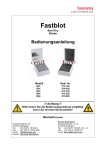
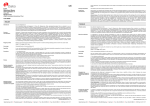
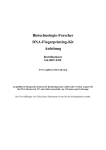

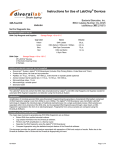
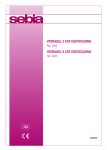
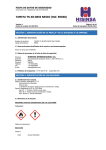
![HL-2-1436P_2007-06(5) [Titan III acetate].qxp](http://vs1.manualzilla.com/store/data/006198024_1-3755b6b3fcb71fbd9e81263f511c5484-150x150.png)
